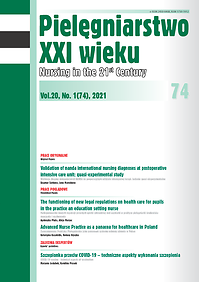Concerns of pregnant women and women in childbed during the pandemic
DOI:
https://doi.org/10.2478/pielxxiw-2021-0001Keywords:
COVID-19, pregnancy, concernsAbstract
CONCERNS OF PREGNANT WOMEN AND WOMEN IN CHILDBED DURING THE PANDEMIC
Aim. The purpose of the paper was to determine the type of concerns of pregnant women and women in childbed during the announced state of pandemic in the country.
Material and methods. The study included a group of 102 women, including 87 (85.3%) pregnant women and 15 (14.7%) puerperal women. A self-written questionnaire containing 18 questions was used for the study. The comparison of the values of the qualitative variables in the groups was performed using the chi-square test or Fisher's exact test. The statistical analysis was performed in the R program, version 4.0.2.
Results. In the study group, the respondents' greatest fear was childbirth without an accompanying person. A frequent cause of concern among the respondents was the limitation of follow-up visits to the doctor or midwife providing prenatal care. Limited physical activity during the pandemic also turned out to be a significant concern. Only 11.8% of the respondents did not feel any fear in their current pregnancy. Additionally, among the reasons for their concerns, the respondents mentioned, among others: fear of separation of mother and child after delivery, the need to care for an older child, no visits to specialists, fear of infection with SARS CoV-2 virus. Statistical analysis confirmed a significant correlation between the number of children already owned and the concerns of pregnant women regarding being resourceful in caring for themselves and their child after returning home.
Conclusions. The duration of the pandemic is a significant stress factor for a pregnant woman. A significant group of female respondents was concerned about the deterioration of maternity care and infection with the virus during hospital stay. Therefore, the task of medical personnel is to provide mental support and educate patients.
References
1. Pawlicka P, Chrzan-Dętkoś M, Lutkiewicz K. Prężność psychiczna przyszłych matek oraz kolejność ciąży jako moderatory budowania więzi z nienarodzonym jeszcze dzieckiem. Family Forum. 2013; 3: 139-154.
2. Kaźmierczak M, Sołdyńska M, Gierszewska M, i wsp. Ocena lęku przed porodem u kobiet ciężarnych. Piel. Zdr. Publ. 2017; 26(1): 69-75.
3. Glynn LM, Schetter CD, Hobel CJ, et al. Pattern of perceived stress and anxiety in pregnancy predicts preterm birth, Health Psychology. Official Journal Of The Division Of Health Psychology, American Psychological Association. 2008; 27: 43-51.
4. Sęk H. Rola wsparcia społecznego w sytuacjach stresu życiowego. O dopasowaniu wsparcia do wydarzeń stresowych. [w:] Sęk H, Cieślak R, red. Wsparcie społeczne, stres i zdrowie. Warszawa: PWN; 2004, s. 18-19, 49-67.
5. Jośko-Ochojska J. Traumatyczne przeżycia matki ciężarnej a zdrowie jej dziecka. Dziecko krzywdzone. Teoria, badania, praktyka. 2016; 15(3): 117-129.
6. Bączyk G, Cebulska V, Koźlak V, i wsp. Poziom lęku przedporodowego u kobiet w ciąży. Probl. Hig. Epidemiol. 2011, 92(4): 774-777.
7. Dembińska A, Wichary E. Wybrane psychospołeczne korelaty lęku przedporodowego – znaczenie dla praktyki położniczej. Sztuka leczenia. 2016; 1: 43-54.
8. Wujtewicz MA, Dylczyk-Sommer A, Aszkiełowicz A, i wsp. COVID-19 – co dzisiaj powinien wiedzieć anestezjolog. Anestezjologia i Intensywna Terapia. 2020; 52(1): 1-9.
9. Zgliczyńska M, Kosińska-Kaczyńska K. Przebieg infekcji SARS-CoV-2 u kobiet ciężarnych – przegląd literatury. Wiedza Medyczna – numer specjalny. 2020: 24-30.
10. Europejskie Centrum ds. Zapobiegania i Kontroli Chorób (ECDC), COVID-19: Situation update worldwide, ecdc.europa.eu [dostęp 2020-07-25].
11. Coronavirus COVID-19 Global Cases, Johns Hopkins University, 25 lipca 2020 [dostęp 2020-07-25].
12. Wu Z, McGoogan JM. Characteristics of and Important Lessons From the Coronavirus Disease 2019 (COVID-19) Outbreak in China: Summary of a Report of 72314 Cases From the Chinese Center for Disease Control and Prevention. JAMA. 2020.
13. Danerek M, Dykes AK. A theoretical model of parents’ experiences of threat of preterm birth in Sweden. Midwifery. 2008; 24: 416-424.
14. Weidner K, Bittner A, Junge-Hoffmeister J, et al. A psychosomatic intervention in pregnant in-patient women with prenatal somatic risks. J. Psychosom. Obstet. Gynaecol. 2010; 31: 188-198.
15. Maloni JA. Lack of evidence for presctription of antepartum bed rest. Expert Rev. Obstet. Gynecol. 2011; 6: 385-339.
16. Di Mascio D, Khalil A, Saccone G, et al. Outcome of Coronavirus spectrum infections (SARS, MERS, COVID-19) during pregnancy: a systematic review and meta-analysis. Am. J. Obstet. Gynecol. MFM. 2020; 2(2): 100107.
17. Royal College of Obstetricians and Gynaecologists, Royal College of Midwives, Royal College of Paediatrics and Child Health, Public Health England and Health Protection Scotland. Coronavirus (COVID-19) Infection in Pregnancy. Information for healthcare professionals. Version 4: Published Friday 3 April 2020.
18. Kanadys K, Rogowska J, Lewicka M, Wiktor H. Satysfakcja z życia kobiet ciężarnych. Medycyna Ogólna i Nauki o Zdrowiu. 2015; 21(1), 45-48.
19. Hossain N, Samuel M, Sandeep R, et al. Perceptions, Generalized Anxiety and Fears of Pregnant women about Corona Virus infection in the heart of Pandemic. 2020, DOI:10.21203/rs.3.rs-32235/v1 [dostęp: 2020-09-15].
20. Ross LE, McLean LM. Anxiety disorders during pregnancy and the postpartum The Journal of clinical psychiatry. 2006; 67(8):1285-1298.
21. Wu Y, et al. Perinatal depressive and anxiety symptoms of pregnant women during the coronavirus disease 2019 outbreak in China. Am. J. Obstet. Gynecol. 2020; Aug; 223-240.
Downloads
Published
Issue
Section
License
Copyright (c) 2021 Authors

This work is licensed under a Creative Commons Attribution-NonCommercial-NoDerivatives 4.0 International License.




